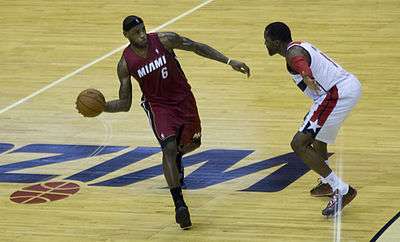Point forward

Point forward is an unofficial playing position in basketball for those who share the attributes of both a point guard and a forward.
Characteristics
A point forward is a forward who is responsible for being the primary facilitator on offense.[1][2] The player is typically responsible for bringing the ball up the court.[3] In some cases, the point forward directs the offense once a traditional point guard dribbles the ball up-court.[4][5][6] The role is generally filled by a small forward and rarely by a power forward.[2][3][7]
ESPN analyst Dave Telep believed that a point forward was more than a forward who was a good passer, but also needed to facilitate the offense for teammates at least half of the time.[1] Former National Basketball Association (NBA) player Larry Bird, lauded for both his scoring and passing skills,[8] once said "I'm a point forward now" after he believed coaches wanted him to score less and pass more.[9][10]
Don Nelson, a coach often associated with point forwards in his Nellie Ball system,[11] used them to compensate for weaknesses on his team, such as having guards that were not strong ball-handlers.[2] Other coaches have used point forwards to free their guards to score.[11] In some cases, a team employs a point forward when a forward is their best playmaker.[2]
Origin of the term
Three former members of the Milwaukee Bucks in the National Basketball Association (NBA) all claim to have originated the point forward term. Former Bucks player Marques Johnson claims to have coined the term. During the 1984 playoffs, Milwaukee became short on point guards after Nate Archibald was sidelined with a hamstring injury. His coach, Don Nelson, instructed Johnson to set up the offense from his forward position. Johnson responded, "OK, so instead of a point guard, I'm a point forward".[12] However, Del Harris, then-Bucks assistant coach, claims that he first mentioned the term to Nelson while discussing strategies to use Paul Pressey. Harris says he came up with the term while coaching Robert Reid with the Houston Rockets. Harris credits his predecessor as Rockets coach, Tom Nissalke, with creating the point forward strategy with Rick Barry's role in Houston.[12]
Styles of play
One of the first examples of an NBA point forward was John Johnson, who played the point forward role for the Seattle SuperSonics of the 1970s, alongside two guards who were more scoring-minded in Gus Williams and Dennis Johnson.[13] Some other notable examples are Marques Johnson and Paul Pressey, who both played that role while under Head Coach Don Nelson for the Milwaukee Bucks in the 1980s.[14][15] Perhaps the most notable NBA point forwards are the 6'9" Larry Bird, who while playing as a small forward or power forward often ran the offense for the great Boston Celtics teams of the 1980s;[16] the 6'9" Earvin "Magic" Johnson, who orchestrated the Los Angeles Lakers' offense in the 1980s as the team's point guard, moved to a point forward role upon returning 27 pounds (12 kg) heavier after his HIV announcement.[17]
See also
References
- 1 2 Halley, Jim (July 20, 2012). "Analysts say point forwards are few and far between". USA Today. Archived from the original on March 22, 2014.
- 1 2 3 4 Guile, Aaron (October 17, 2013). "Aaron Guile: Gordon Hayward — the emerging point forward". Deseret News. Archived from the original on March 22, 2014.
- 1 2 Frazier, Walt; Sachare, Alex (2004). The Complete Idiot's Guide to Basketball. Penguin. pp. 97–8. ISBN 9780786549894. Retrieved March 22, 2014.
- ↑ Eisenberg, John (August 19, 1992). "Imaginations soared with the best Bird". The Baltimore Sun. Archived from the original on March 22, 2014.
- ↑ Smith, Sam (July 8, 2010). "WHAT WOULD MICHAEL DO? NOT THIS!". NBA.com. Archived from the original on March 22, 2014.
- ↑ Berkow, Ira (2004). Court Vision: Unexpected Views on the Lure of Basketball. U of Nebraska Press. p. 209. Retrieved March 22, 2014.
- ↑ Windhorst, Brian (September 28, 2012). "LeBron eyeing 'point power forward' role?". ESPN.com. Archived from the original on March 22, 2014.
- ↑ Bjarkman, Peter C. "Boston Celtics Encyclopedia". Sports Publishing. pp. 40–1. ISBN 9781582615646. Retrieved March 22, 2014.
- ↑ Winderman, Ira (November 26, 1989). "Impact Players? Ask Teams They Control". Sun-Sentinel. Archived from the original on March 22, 2014.
- ↑ Smith, Sam (December 3, 1989). "Pro Basketball". Chicago Tribune. Archived from the original on March 22, 2014.
- 1 2 Winn, Luke (March 16, 2009). "From This Point Forward". Sports Illustrated. Archived from the original on March 22, 2014.
- 1 2 Aschburner, Steve (December 21, 2010). "LeBron a point forward? Well, he wouldn't be the first". NBA.com. Archived from the original on June 1, 2012.
- ↑ "John Johnson: Point Forward". NBA .com. Retrieved 2008-04-23.
- ↑ "Basketball U on Swingmen". NBA .com Canada. Retrieved 2007-09-06.
- ↑ "Original point forward". hoopshype .com. Retrieved 2008-08-23.
- ↑ Ventre, Michael (January 30, 1996). "He Will Give Us All a Lift". Daily News. Los Angeles. Retrieved December 7, 2012.
A point power forward. Think of it. It will be similar to the days when Dennis Johnson or Danny Ainge brought the ball across midcourt for the Celtics, passed to Larry Bird, and then let him direct the offense.
(subscription required) - ↑ Meinecke, Corky (January 30, 1996). "Magic waited too long". The News (Boca Raton). p. 5B. Retrieved June 1, 2012.
